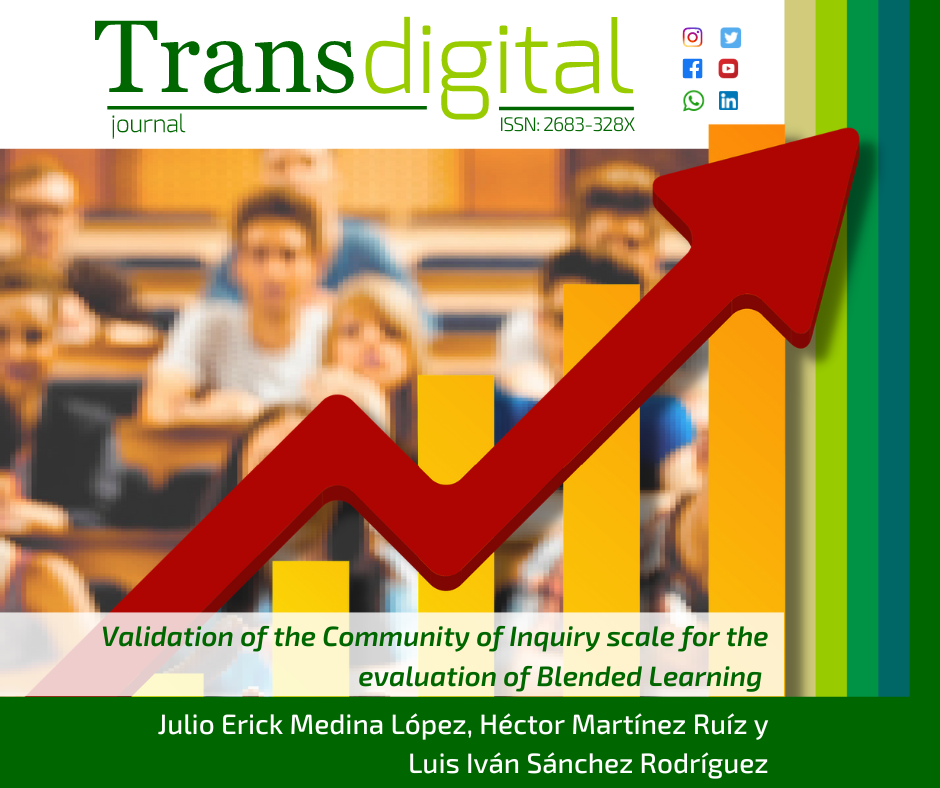Validation of the Community of Inquiry scale for the evaluation of Blended Learning
DOI:
https://doi.org/10.56162/transdigital131Keywords:
Community of Inquiry Survey, social presence, cognitive presence, teaching presence, exploratory factor analysisAbstract
The Community of Inquiry (CoI) model is an alternative in the online learning process with constructivist theoretical foundations. For learning in virtual environments to be effective, it requires the participation of a community and considers three presences for the development of a successful learning experience: cognitive presence, social presence, and teaching presence. The purpose of the study was to analyze the validity and reliability of the Community of Inquiry (CoI) survey developed by J. Ben Arbaugh to evaluate the CoI model. For this purpose, the instrument was applied to 144 undergraduate students at the Autonomous University of Tamaulipas during the second semester of 2021. In the final solution it was identified that the items are grouped into three factors, explained by 68.66% of the variance. In the internal consistency analysis using Cronbach's alpha, the three presences of the scale resulted with high reliability (teaching presence= 0.975, social presence=0.929 and cognitive presence=0.958). The scale resulted in Cronbach's alpha= 0.975. The results indicate that the instrument is valid for evaluating the implementation of Blended Learning under the above model.
References
Abbitt, J. T. y Boone, W. J. (2021). Gaining insight from survey data: an analysis of the community of inquiry survey using Rasch measurement techniques. Journal of Computing in Higher Education, 33, 367–397. https://doi.org/10.1007/s12528-020-09268-6
Arbaugh, B. (2007). An Empirical Verification of the Community of Inquiry Framework. Online Learning, 11(1), 73–85. https://doi.org/10.24059/olj.v11i1.1738
Arbaugh, J. B., Cleveland-Innes, M., Diaz, S. R., Garrison, D. R., Ice, P., Richardson, J. C. y Swan, K. P. (2008). Developing a community of inquiry instrument: Testing a measure of the Community of Inquiry framework using a multi-institutional sample. Internet and Higher Education, 11(3–4), 133–136. https://doi.org/10.1016/j.iheduc.2008.06.003
Ballesteros, B., Gil, I. y Morentín, J. (2019). Validación de la versión en castellano del cuestionario “Community of Inquiry”. Revista de Educación a Distancia (RED), 1(59), 1–26. https://doi.org/10.6018/red/59/04
Campo-Arias, A. y Oviedo, H. (2008). Propiedades Psicométricas de una Escala: la Consistencia Interna. Revista de Salud Pública, 10(5), 831–839.
Carlon, S., Bennett-Woods, D., Berg, B., Claywell, L., Leduc, K., Marcisz, N., Mulhall, M., Noteboom, T., Snedden, T., Whalen, K. y Zenoni, L. (2012). The community of inquiry instrument: Validation and results in online health care disciplines. Computers and Education, 59(2), 215–221. https://doi.org/10.1016/j.compedu.2012.01.004
Frías-Navarro, D. (2021). Apuntes de consistencia interna de las puntuaciones de un instrumento de medida. En Recomendaciones para elaborar y redactar el informe de investigación (pp. 1–22). https://www.uv.es/friasnav/AlfaCronbach.pdf
Garrison, D. R., Anderson, T., & Archer, W. (1999). Critical Inquiry in a Text-Based Environment: Computer Conferencing in Higher Education. The Internet and Higher Education, 2(2), 87–105. https://doi.org/10.1016/S1096-7516(00)00016-6
Garrison, R. y Vaughan, N. (2008). Blended Learning in Higher Education: Framework, Principles and Guidelines. Wiley.
Horzum, M. B. y Uyanik, G. K. (2015). An item response theory analysis of the community of inquiry scale. International Review of Research in Open and Distance Learning, 16(2), 206–226. https://doi.org/10.19173/irrodl.v16i2.2052
Kozan, K. y Richardson, J. C. (2014). New exploratory and confirmatory factor analysis insights into the community of inquiry survey. Internet and Higher Education, 23(October 2014), 39–47. https://doi.org/10.1016/j.iheduc.2014.06.002
Lloret, S., Ferreres, A., Hernández, A. y Tomás, I. (2014). El análisis factorial exploratorio de los ítems: una guía práctica , revisada y actualizada. 30, 1151–1169.
López, G. (2012). Pensamiento crítico en el aula. Docencia e Investigación: revista de la Escuela Universitaria de Magisterio de Toledo, 37(22), 41–60.
López, M. y Gutiérrez, L. (2019). Cómo realizar e interpretar un análisis factorial exploratorio utilizando SPSS. REIRE Revista d Innovació i Recerca en Educació, 12 (2), 1–14. https://doi.org/10.1344/reire2019.12.227057
Ma, Z., Wang, J., Wang, Q., Kong, L., Wu, Y. y Yang, H. (2017). Verifying causal relationships among the presences of the Community of Inquiry framework in the Chinese context. International Review of Research in Open and Distance Learning, 18(6), 213–230. https://doi.org/10.19173/irrodl.v18i6.3197
Marinoni, G., Land, H. Van y Jensen, T. (2020). The Impact of Covid-19 on Higher Education around the world IAU Global Survey Report. https://www.iau-aiu.net/IMG/pdf/iau_covid19_and_he_survey_report_final_may_2020.pdf
Moreira, J y Almeida, A. (2011). How reliable and consistent is our learning community of inquiry? Psychometric qualities of the Community of Inquiry survey instrument applied to a sample of higer education portuguese students. Internacional Conference on Education and New Learning Technologies (EDULEARN), 4261–4266. https://repositorioaberto.uab.pt/handle/10400.2/2919
Moreira, José, Ferreira, A. y Almeida, A. (2013). Comparing communities of inquiry of Portuguese higher education students: One for all or one for each? Open Praxis, 5(2), 165. https://doi.org/10.5944/openpraxis.5.2.50
Olpak, Y. Z. y Kiliç Çakmak, E. (2018). Examining the reliability and validity of a turkish version of the community of inquiry survey. Online Learning Journal, 22(1), 147–161. https://doi.org/10.24059/olj.v22i1.990
Pardo, H. y Cobo, C. (2020). Expandir la universidad más allá de la enseñanza remota de emergencia. Outliers School, enseñanza remota de emergencia, 8. http://outliersschool.net/project/universidadpostpandemia/
Romero, P. K. y Mora, O. M. (2020). Análisis factorial exploratorio mediante el uso de las medidas de adecuación muestral kmo y esfericidad de Bartlett para determinar factores principales. Journal of Science and Research, 5, 903–924.
Shea, P. y Bidjerano, T. (2009). Community of inquiry as a theoretical framework to foster “epistemic engagement” and “cognitive presence” in online education. Computers and Education, 52(3), 543–553. https://doi.org/10.1016/j.compedu.2008.10.007
Swan, K. P., Richardson, J. C., Ice, P., Garrison, D. R., Cleveland-Innes, M. y Arbaugh, J. Ben. (2008). www.e-mentor.edu.pl/eng Validating a Measurement Tool of Presence in Online Communities of Inquiry Figure 1: Community of Inquiry Framework. E-mentor, 2(24), 1–12. http://online.purdue.edu/sites/purdue/files/Validating-a-Measurement-Tool-of-Presence-in-Online-Communities-of-Inquiry.pdf

Downloads
Autor de correspondencia
El autor de correspodencia se identifica con el siguiente símbolo: *Published
How to Cite
License
Copyright (c) 2022 Julio Erick Medina López, Héctor Martínez Ruíz, Luis Iván Sánchez Rodríguez

This work is licensed under a Creative Commons Attribution 4.0 International License.
All articles in Transdigital are licensed under a Creative Commons Attribution 4.0 International License. Authors hold the copyright and retain publishing rights without restrictions.









